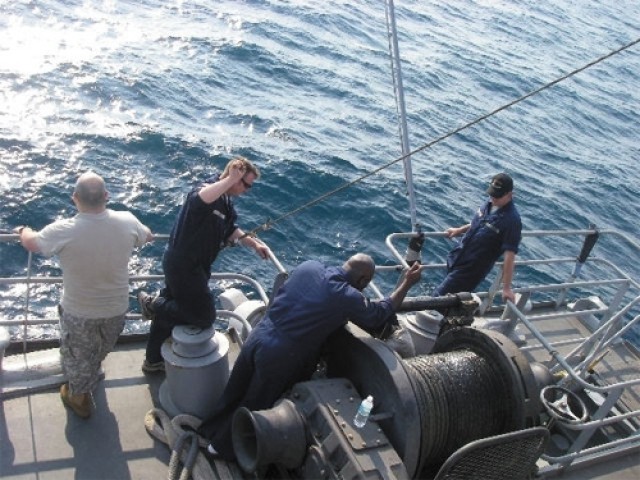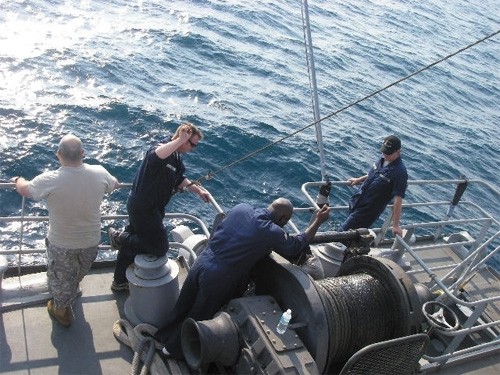
FORT EUSTIS, Va. (Army News Service, July 12, 2007) - Soldiers from the 97th Transportation Company recently returned from a more unconventional mission - recovering thousands of tires from off the Florida coast in an effort to dismantle the world's largest man-made reef.
The 15 Soldiers spent two and a half months off the Florida coast, conducting training operations for dive teams. They then traveled down coast to Fort Lauderdale, where they began a historic effort in environmental preservation.
"In 1972 a number of organizations with good intentions dropped about two million tires in the Atlantic Ocean in an effort to build the world's largest man-made reef," said Chief Warrant Officer Shane Sherrad, vessel master for the LCU-2017, El Caney. "In reality, nothing grew, and the tires began to drift, damaging the existing reefs on either side of the man made reef. Our job was to figure out how to recover the tires in order to protect the other reefs."
The hundreds of thousands of tires lining the ocean bottom have begun to wash up on local shores and into existing marine life, making them a hazardous presence on the ocean floor. The mission is an unconventional one, and the LCU-crew faced the task with no existing template of how to complete the project.
Upon arriving in Florida, the Soldiers were given several plans for completing the mission.
"We reviewed those plans, told them what would work and what wouldn't. In the end, we tried three different plans and chose the best from there," Chief Sherrad said.
The crew settled on a plan that had them take position between the two live reefs running parallel with the coast, where divers would bundle approximately 50 to 60 tires together with a steel cable. The tires were then brought to the surface with lift bags and towed into the LCU, lifted with a crane and dropped into the containers.
The operation was an exercise in environmental responsibility. After the tires were collected, they were transported to a Georgia facility where they will be burned to create energy to power a recycling plant.
"The whole mission was about recycle, recycle, recycle," Chief Sherrad said.
The Eustis LCU crew manned the boat for the entire mission, with Army, Navy and Coast Guard divers participating together to recover the tires.
"It was a great experience, being with the three branches and working there together," said Staff Sgt. Don Morales, who worked on the deck, brining on containers and tires and doing other maintenance to ensure the boat was in peak performance.
The crew got no small share of media attention, with individuals from CNN, Discovery and a number of area newspapers and television stations reporting the mission.
"It's such a significant environmental issue," Chief Sherrad said. "There were individuals from Germany and England there. There was a big interest in how we were doing it, because others would like to be able to take on projects like this themselves. We're taking down the world's largest artificial reef. It had never been done before, and we had to find a way to do it."
The mission was an opportunity for the Army to showcase its skills in environmental protection.
"The Army goes well above and beyond the civilian environmental laws," Chief Sherrod said. "There isn't a civilian company out there who sticks to the same environmental standards the Army does."
Sgt. 1st Class Jose Lopez acted as the second in command. "On a daily basis, everything we do is about environmental protection," he said.
In addition to helping the environment, the mission also helped save the state of Florida millions of dollars. The project would have taken $20 million to complete using civilian funds, but will cost just $2 million with the military taking the helms.
The Soldiers moved thousands of tires during the mission, and it is slated to continue into 2010. Summer crews of Army vessels and divers will continue to visit the coasts of Florida each summer and remove the tires.
(Lindy Dinklage works for the Fort Eustis Public Affairs Office.)

Social Sharing